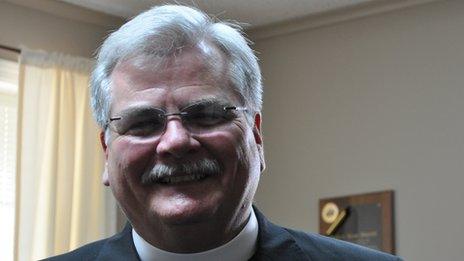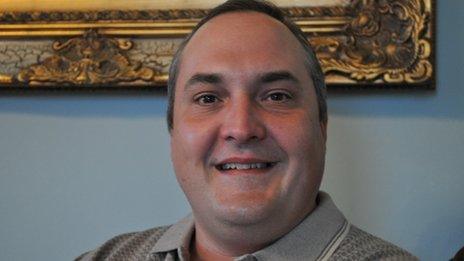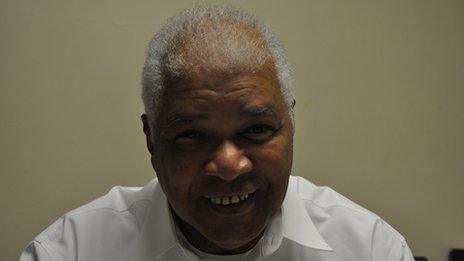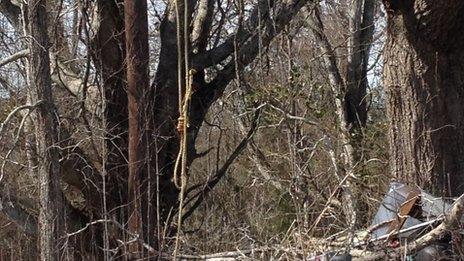Louisiana grapples with '12 Years' legacy
- Published
Eakin, right, spent years proving the authenticity of Northup's tale of suffering and enslavement, reports the BBC's Rajini Vaidyanathan in Louisiana
The film 12 Years a Slave has been praised for its vivid portrayal of slavery in America's South. Based on a book of the same name, it tells the true story of Solomon Northup, a free man who is kidnapped and enslaved in rural Louisiana. But how does the legacy of the film live on today?
The book had been out of print for decades before it was rediscovered by historian Sue Eakin, who lived in the same area, Rapides Parish, where Northup was enslaved.
Eakin first read it at a friend's house at age 12, then found it again at her college bookstore and was "mesmerised" by it.
As her great-nephew Lamar White explains, the man who sold her the book told her it was "a pack of lies".
Determined to prove him wrong, she devoted her life to researching the book's authenticity and republished an edited version in 1968 with fellow historian Joseph Logsdon.
Eakin faced many challenges as a white woman championing the story of a black slave at a time when America was deeply segregated.
"It's difficult to build a community when there's that giant gaping psychic wound that slavery inflicted," says White. "It was easier for people to get along if they ignored it."
Even today, there are many here who refuse to acknowledge this area's tortured history.
At a two-day discussion on the book held recently at Louisiana State University, the legacy of Northup's story was debated by a group of black and white Americans.

Bob Vincent
Ginger Jones, who leads the university's multicultural committee, says her initial proposal to host a symposium on race relations met with resistance.
"We had too many people who felt they were going to relive the Civil War or the civil rights movement and I think they were a little frightened about it," she says.
Karen Riley, a panellist at the symposium, moved to the area from New Orleans in the aftermath of Hurricane Katrina. She says as a newcomer she found very little social integration between blacks and whites.
"What appears to me almost are two different cities," she says. "There is no crossover, and I found that curious."
A friend whose ancestors were slaves in the area refused to attend the symposium because it was too painful a topic.
"There's shame, fear and mistrust that lingers even more than 150 years on," says Riley.
She points to a lack of memorials to slaves and the way many in the South celebrate and re-enact the start of the Civil War as reasons many blacks continue to feel uncomfortable.

Tony Ward feels "no guilt" for his ancestors' ownership of slaves
"It's a bit schizophrenic to live in an area that celebrates the war that was trying to keep your ancestors enslaved, and I think that might be why some in the black community don't want to discuss it, because those ideals are still alive here."
Talk to many here and they'll tell you the film has been a blessing and a curse - highlighting an important story, but also casting a spotlight on events which happened a long time ago.
I meet Tony Ward at a former plantation home, Loyd Hall, which was built by slaves. Immaculately restored, it's now a bed and breakfast.
The descendant of slave owners, Ward wonders why, if slavery was so bad, so many freed slaves remained in the area.
"I feel no guilt for what my ancestors did," he says. They were only operating by the standards of the day, he says.
"They took a bad situation and made the best of it they could."

Edward Larvadain Jr believes white people in the area would vote to restore slavery if they didn't have to show their hands
He says it's time for people to move on.
"We have enslaved ourselves to making right things that our ancestors have done, and we don't need to do it any more."
It's a hotly contested view. Speak to many African Americans here and they'll tell you they are still suffering from the legacy of slavery.
"Black folks wanted our fair share of the pie. And as of this day we have not gotten our fair share of the pie," says Edward Larvadain Jr, a lawyer and veteran civil rights activist.
Larvadain says he believes white people in the area would vote to bring back slavery if they didn't have to show their hands in public.
"Solomon Northup's story happened here in Rapides Parish and I've had to deal with those type of white folks for 47 years," he says.
"It hasn't been good."

In Cheneyville, Louisana, I saw a noose hanging inexplicably from a tree
It's clear the wounds inflicted by slavery run deep, and challenging such entrenched views isn't easy.
Bob Vincent, a white pastor at Grace Presbyterian Church whose ancestors were slave owners, believes the conversation will only open up if white America fully acknowledges the past.
"Here in America our hands are very bloody with the legacy of slavery," he says.
He sees hypocrisy that so many monuments remember the Holocaust while so few commemorate slavery.
"Where are the monuments to America's holocaust?" he says.
As I leave Louisiana I'm struck by an image I encountered close to the land where Solomon Northup worked: a noose hanging from a tree.
It's an uncomfortable reminder that no matter how much people may want to move forward, the past is still present in Rapides Parish.